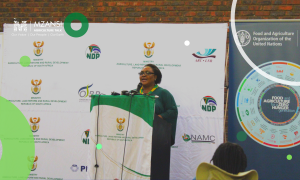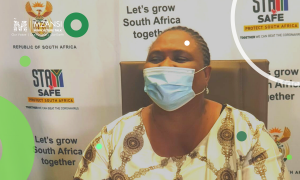Rising agricultural input costs continue to be a major expense to South Africa’s food production and affordability, particularly fuel, freight, and fertilizers. This is concerning, since South Africa largely depends on imported agricultural inputs. High input costs are associated with reduced farm profitability, and the persistent food inflation, even though global prices have somewhat moderated. These factors highlight the urgent need for coordinated efforts to stabilize regional input markets and increase the resilience to shocks by the food systems. Shocks compromise the agriculture sector’s competitiveness and increase consumers’ cost of living.According to food and input cost report of quarter-2 for the (2025/26) published by the NAMC, local input costs remain high because of the depreciating value of the Rand against the United States dollar (US$), coupled with the ongoing instability in international markets. All these factors affect the country’s food security status, consumer food prices, and margins received by farmers.
International Fertiliser Markets
Since 2021, global fertiliser prices have been volatile, mainly due to among other factors, (i) the Russia–Ukraine conflict; (ii) energy market changes; and (iii) shifting trade policies. Between August 2021 and August 2025, the international price of Di-Ammonium Phosphate (DAP) rose by 16%, as Urea went up by 8%. Conversely, the price of the Muriate of Potash (MOP) and Ammonia fell by 23% and 48%, respectively. For South African farmers, these changes are felt even more sharply because the Rand has weakened against the US$ by about 20% over the same period. In local currency, DAP and Urea prices increased by 39% and 29%, respectively, while MOP and Ammonia prices dropped by 7% and 37%, respectively. A detailed Food and Input Cost report is accessible here.
Domestic Fertiliser Prices
In South Africa, fertiliser prices have tracked global volatility but remain persistently high due to the country’s dependence on imported raw materials and finished products. From August 2021 to August 2025, prices for key fertilisers like Mono-Ammonium Phosphate (MAP) and Limestone Ammonium Nitrate (LAN) rose by 17%, while Urea increased by 6%, with Potassium Chloride (KCl) being the only major fertiliser that declined (11%). Comparing August 2024 to August 2025, MAP, Urea, KCl, and LAN prices spiked by 6 –14%, largely due to the depreciation of the Rand and higher global transport costs. This persistent upward trend in fertiliser prices continues to erode farmers’ profit margins, particularly for smallholder and medium-scale producers who have limited access to finance for bulk purchasing options.
Fuel Price Developments
The rising fuel cost continues to strain South Africa’s agricultural sector, affecting everything from mechanised production operations to post-harvest logistics. Between 2019 and 2025, petrol and diesel prices increased by 35% and 40%, respectively, reaching over R20 per litre. Added levies, transport margins, and refining costs keep domestic fuel prices high, driving up production and distribution expenses and, in turn, the cost of inputs like irrigation fuel, transport, and refrigeration.
Freight and Logistics Costs
Freight and logistics costs continue to influence South Africa’s agricultural input prices. In early 2025, the Baltic Dry Index rose by 16.6% year-on-year, while the Grain and Oilseed Freight Index fell by 3%, reflecting mixed trends in global shipping costs. Despite some easing, freight costs remain high, raising the landed prices of imported fertilisers, chemicals, and fuels, and directly affecting domestic production costs and the agricultural sector’s export competitiveness.
Implications for South Africa’s Agricultural Sector
The rising cost of agricultural inputs has wide-ranging effects across the agrifood system. For farmers, the continued increase in fertiliser and fuel prices has raised production expenses, eroded profit margins, and in some cases led to delayed or reduced planting. Smallholder farmers are particularly vulnerable, as they often lack the financial capacity to absorb price shocks or invest in cost-saving technologies. Higher production costs have forced many to lower fertiliser application or reduce cultivated areas, potentially reducing yields and the overall output. For consumers, these cost pressures are passed along the value chain, contributing to higher retail food prices. By July 2025, food and non-alcoholic beverage inflation reached 5.7%, exceeding the headline consumer price index (CPI) of 3.5%. This highlights the ongoing influence of input costs on food inflation.
Suggested interventions
In mitigation of these challenges, several policy interventions are suggested. First, diversifying fertilizer supply chains by promoting local production and regional procurement partnerships within the Southern Africa Development Community (SADC) can reduce reliance on international suppliers. Second, enhancing transparency in input costs transmission through regularly updated price monitoring dashboards is likely to assist farmers to plan and manage expenses more effectively. Third, expanding support to cost-efficient and sustainable farming practices such as regenerative agriculture, precision agriculture, integrated soil fertility management, and organic nutrient recycling may lower dependence on chemical fertilizers. Fourth, encouraging investment in renewable energy and alternative fuels for farm mechanization may gradually lessen vulnerability to fossil fuel price fluctuations.
In summary, South Africa’s agricultural input markets continue to face pressure from global market instability, depreciation of the local currency, and structural reliance on imports. Even though international fertilizer and fuel prices are stabilizing, their impact on the domestic market remains amplified by exchange-rate movements and logistical-ports inefficiencies. These factors are expected to keep production costs and food inflation on the rise through 2025/26. In the spirit of the Agriculture and Agro-processing Master Plan (AAMP) a coordinated effort amongst government, agribusiness, financial institutions and other social partners is essential to stabilize input markets, strengthen producer resilience, and ensure national food security.
Disclaimer: The views expressed in this article is solely that of Naledi Radebe, Economist at the NAMC, and does not necessarily reflect the views of Mzansi Agriculture Talk, her employers, or other associated parties.




















